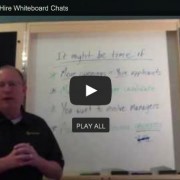What makes Talent Acquisition so hard (and important)
Talent Acquisition (TA) is a complicated but highly rewarding concept. For Human Resources professionals focused in the realm of TA, they are on a high speed roller coaster with multiple twists and turns that can often lead them on a white knuckled trip. What makes talent acquisition so hard, and yet so important, is the main focus of the task. TA is a competitive, time-sensitive task that can yield disappointment but also joyous rewards. To really ensure you acquire the best talent you need ExactHire’s ATS. This allows you to compare hundreds of candidates against various criteria to get the best candidate for your position.
Talent Acquisition Challenges
The main reason TA can be so challenging yet rewarding is the same – the people factor. In the current job market, the talent pool is very competitive due to disproportionate numbers of skilled available talent compared to the number of vacant jobs. The competition is fiercely competitive. Rival companies are recruiting the same candidates that TA professionals seek to hire. Getting the message out to job seekers about the company’s vacancies and the company’s stellar branding to entice them to apply and pursue the company takes precision to filter through competitors’ noise. TA specialists can resonate their message more clearly and combat the noise by ensuring that company branding promotes the company as being the employer of choice due to culture.
Having a culture inclusive to employees with benefits that meets and exceeds the needs of employees solidifies TA’s claims to job seekers that their company is the one for job seekers. If job vacancies in certain geographic areas are more difficult to fill, examine what could help with filling those roles. Consider expanding the candidate search to additional areas or explore options for remote or hybrid work settings to attract more candidates. Utilize social media to its fullest and promote vacant job listings on major platforms. Social media platforms reach target audiences of differing ages and backgrounds. Using different social media platforms allows TA professionals to reach job seekers with diverse demographics.
The “People Factor”
Digging deeper into the people factor. What if applicants are plentiful, but none are perceived to have the needed skill set to be fully qualified to fill the vacant roles within an organization? This is where TA must partner closely with the department leaders of the vacant roles. Focus on the required skills needed for the vacant role. Candidates that meet those required skills can be evaluated further. They then identify the reasons why Human Resources cannot completely commit to extending a job offer.
For candidates who are contenders for a role but not 100% vetted, explore what it would take to mold a candidate for the vacant role in which they applied. The “perfect” candidate is equivalent to a unicorn; sought-after, beautiful and fictitious. If there are candidates for vacancies that can be shaped into productive contributors to an organization with some assistance upon hire, consider providing that assistance. It is possible that extra training or classes could be beneficial. The financial investment initially could pay off more down the road. A new hire will then have been given the opportunity to refine weaker areas to enhance their performance. Investing in employees, particularly new hires, can lead to higher employee retention and productivity.
Screening Candidates
Upon review of candidates, TA must be tasked with screening those who are potential for the company. TA is often the first impression of a company so TA professionals must display professionalism with a personable demeanor. Phone screens and interviews, whether face-to-face or virtual, generate nervousness in the minds of job seekers. TA professionals should create a positive rapport with interviewees. they can do this through sincerity and a genuine interest in learning more about the person’s desire to work for the company. Establishing a dialogue that is reflective of the company culture of inclusivity will help TA professionals formulate a working relationship with job seekers that help set a competitive edge. The best job seekers will be receiving employment offers from multiple companies. Job seekers will migrate to the company that demonstrates a bona fide interest in employees. This will help attract stellar job seekers from competitors.
How to make Talent Acquisition Easier
Monitoring efficiency in talent acquisition can be challenging if data is not being collected and analyzed. Using an Applicant Tracking System (ATS) consolidates applicant data into a central location for analysis and communication by TA professionals and other designated employees in the hiring process. Having a central location to screen applicant data and communicate with stakeholders in the hiring process saves time and creates a comprehensive trail of actions taken when screening applicant records. Robust reporting tools deliver accessible data quickly to identify efficiency gaps in the hiring process. Using analytics helps TA professionals confidently formulate short-term and long-term goals. These can be used in immediate activities and strategic planning with leadership.
Conclusion
TA professionals work diligently to overcome competitive challenges in the hiring process. It is often a role which entails erratic schedules with long days and weekend events. Disappointment is frequent when TA professionals witness coveted potential talent decline their best pitch at landing them within their organization. While it is a game of wins and losses in a very broad generic sense, talent acquisition hosts a plethora of rewards. Without TA professionals to lead the charge of recruiting and retaining key talent, an organization would be sailing a ship without sails ultimately leading to a lack of sales.
TA professionals relentlessly pursue potential talent. They need to have the support of executive leadership as they navigate the recruitment process. Providing TA professionals with the tools they need for success is the best option for an organization. Then leadership can ensure that the company’s growth and productivity as a whole will weather threatening situations. This will allow them to survive things such as pandemics and global recessions. Talent acquisition is truly a hard but essential component in an organization’s overall health. It is crucial that appreciation is shown to those charged with acquiring talent to the company.









